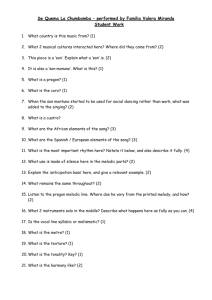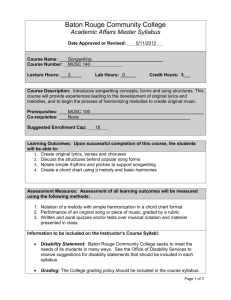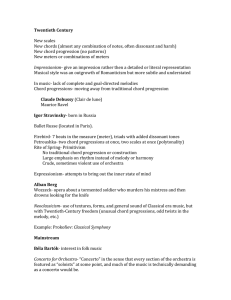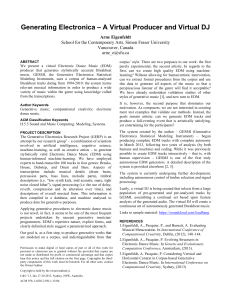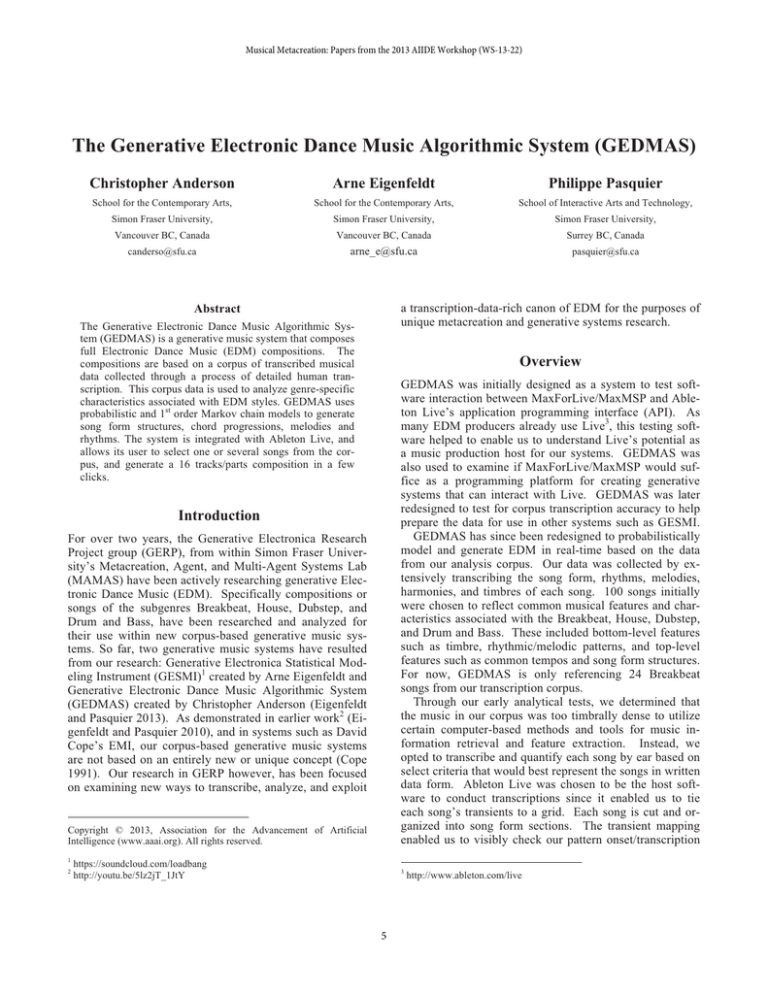
Musical Metacreation: Papers from the 2013 AIIDE Workshop (WS-13-22)
The Generative Electronic Dance Music Algorithmic System (GEDMAS)
Christopher Anderson
Arne Eigenfeldt
Philippe Pasquier
School for the Contemporary Arts,
School for the Contemporary Arts,
School of Interactive Arts and Technology,
Simon Fraser University,
Simon Fraser University,
Simon Fraser University,
Vancouver BC, Canada
Vancouver BC, Canada
Surrey BC, Canada
canderso@sfu.ca
arne_e@sfu.ca
pasquier@sfu.ca
a transcription-data-rich canon of EDM for the purposes of
unique metacreation and generative systems research.
Abstract
The Generative Electronic Dance Music Algorithmic System (GEDMAS) is a generative music system that composes
full Electronic Dance Music (EDM) compositions. The
compositions are based on a corpus of transcribed musical
data collected through a process of detailed human transcription. This corpus data is used to analyze genre-specific
characteristics associated with EDM styles. GEDMAS uses
probabilistic and 1st order Markov chain models to generate
song form structures, chord progressions, melodies and
rhythms. The system is integrated with Ableton Live, and
allows its user to select one or several songs from the corpus, and generate a 16 tracks/parts composition in a few
clicks.
Overview
GEDMAS was initially designed as a system to test software interaction between MaxForLive/MaxMSP and Ableton Live’s application programming interface (API). As
many EDM producers already use Live3, this testing software helped to enable us to understand Live’s potential as
a music production host for our systems. GEDMAS was
also used to examine if MaxForLive/MaxMSP would suffice as a programming platform for creating generative
systems that can interact with Live. GEDMAS was later
redesigned to test for corpus transcription accuracy to help
prepare the data for use in other systems such as GESMI.
GEDMAS has since been redesigned to probabilistically
model and generate EDM in real-time based on the data
from our analysis corpus. Our data was collected by extensively transcribing the song form, rhythms, melodies,
harmonies, and timbres of each song. 100 songs initially
were chosen to reflect common musical features and characteristics associated with the Breakbeat, House, Dubstep,
and Drum and Bass. These included bottom-level features
such as timbre, rhythmic/melodic patterns, and top-level
features such as common tempos and song form structures.
For now, GEDMAS is only referencing 24 Breakbeat
songs from our transcription corpus.
Through our early analytical tests, we determined that
the music in our corpus was too timbrally dense to utilize
certain computer-based methods and tools for music information retrieval and feature extraction. Instead, we
opted to transcribe and quantify each song by ear based on
select criteria that would best represent the songs in written
data form. Ableton Live was chosen to be the host software to conduct transcriptions since it enabled us to tie
each song’s transients to a grid. Each song is cut and organized into song form sections. The transient mapping
enabled us to visibly check our pattern onset/transcription
Introduction
For over two years, the Generative Electronica Research
Project group (GERP), from within Simon Fraser University’s Metacreation, Agent, and Multi-Agent Systems Lab
(MAMAS) have been actively researching generative Electronic Dance Music (EDM). Specifically compositions or
songs of the subgenres Breakbeat, House, Dubstep, and
Drum and Bass, have been researched and analyzed for
their use within new corpus-based generative music systems. So far, two generative music systems have resulted
from our research: Generative Electronica Statistical Modeling Instrument (GESMI)1 created by Arne Eigenfeldt and
Generative Electronic Dance Music Algorithmic System
(GEDMAS) created by Christopher Anderson (Eigenfeldt
and Pasquier 2013). As demonstrated in earlier work2 (Eigenfeldt and Pasquier 2010), and in systems such as David
Cope’s EMI, our corpus-based generative music systems
are not based on an entirely new or unique concept (Cope
1991). Our research in GERP however, has been focused
on examining new ways to transcribe, analyze, and exploit
Copyright © 2013, Association for the Advancement of Artificial
Intelligence (www.aaai.org). All rights reserved.
1
2
https://soundcloud.com/loadbang
http://youtu.be/5lz2jT_1JtY
3
5
http://www.ableton.com/live
accuracy as well as slow the tempo to hear each section in
detail. Because we do not have a large group of transcribers, we are subject to possible human error. We are now
attempting to mediate any human error during transcription
by transcribing each instrumental pattern as a parallel midi
pattern to the original recording in the arrangement. This
allows for future A/B testing of the transcription material
as well as eliminating errors in formatting the transcription
data.
Possible Next Sections
8 bar Sections and Probability of Next Section
GEDMAS generates full songs by running through five
main stages:
A1
A2
A3
A4
A5
A6
B1
A1
0.0
0.0
0.0
0.0
0.0
0.0
0.0
B2
0.0
A2
87.5
0.0
0.0
0.0
0.0
0.0
0.0
0.0
A3
0.0
25.0
0.0
0.0
0.0
0.0
0.0
0.0
A4
0.0
0.0
88.9
0.0
0.0
0.0
0.0
0.0
A5
0.0
0.0
0.0
4.2
0.0
0.0
0.0
0.0
A6
0.0
0.0
0.0
0.0
100.
0.0
0.0
0.0
B1
12.5
75.0
11.1
25.
0.0
100.
0.0
0.0
B2
0.0
0.0
0.0
0.0
0.0
0.0
91.7
0.0
…
1. Overall Form Generation
2. Chord Progression Generation
3. Instrumental Onset Generation
4. Pattern Generation
4. Data Transfer and Playback
Figure 2. A section of the 1st-order transition matrix
of the transcribed forms.
Corpus data is mined from our transcription spreadsheet.
The data is prepped and stored in the GEDMAS Max 6
application. Using a series of subroutines this data is then
analyzed and used to generate form and rhythmic, melodic
and polyphonic pattern data. Once generated, this data is
sent from the GEDMAS application to a MaxForLive
patch housed within a custom Ableton Live Set. The pattern data received by the MaxForLive patch is then used to
fill the MIDI sequence clips in Ableton Live. The form
data received by the patch is then used to playback each
pattern in sequence.
Chord Progression Generation
The chord progressions of each 8 bar section in the corpus
songs have been transcribed and are stored as strings of
chord symbols. The newly generated form is used to select
this chord progression data from the appropriate songs and
forms in the corpus. Each chord progression selected is
also analyzed and labeled at a macro-level for its occurrence beyond 8 bars in the song form. Each new chord
progression is later connected to macro-level sections of
the form.
After analyzing the corpus based on the form of the new
song, a table of chord onset probabilities is filled. This
table is used to generate new chord progressions for the
sections in the new song. These new chord progressions
are also used to define the pitches to be used in generating
the melodies and harmonies while creating a level of horizontal (i.e., temporal) coherence between the instruments.
Chord progression generation is based on calculating probabilities of chord onset occurrences in each form. Future
versions of GEDMAS will generate chord progressions
based on a Markov chain model.
Overall Form Generation
In our transcriptions, we have labeled each section of the
form according to its function in the song structure. This
data is then used for form analysis and generation as demonstrated in earlier versions of GESMI4 (Eigenfeldt 2011).
Figure 1. The transcribed form of Hybrid’s Empire
As an example, Figure 1 represents the full form of a
Breakbeat song called Empire. Each numbered capital
letter represents an 8 bar phrase within the song, therefore
this song consists of 200 bars. GEDMAS borrows this
labeling approach from GESMI, but also incorporates a
method of grouping and labeling each individual 8 bar section into larger groupings of the form. Each grouped section from Figure 1., would be labeled as 1A 1B 1D 1C 1E.
This macro-level labeling is used for the analysis and generation of longer events within the form, such as chord
progressions that may repeat longer than an 8 bar section.
GEDMAS generates forms by way of a 1st-order Markov
chain transition table. Each new section is collected in sequence order and is then converted back into a numbered
lettered format as well as at the macro-level.
4
Instrumental Onset Generation
Once the form and chord progressions have been generated, onsets indicating what instrumental patterns are to be
played, and when, are generated. A table of form onset
probabilities is first created for the onsets in the corpus.
The instruments have been divided and analyzed based on
their respective timbre. The instruments are: Main-Beat
Kit (Kick, Snare, Closed Hi-hat, Open Hi-hat), Auxiliary
Percussion (Claps, Crash Cymbal, Bongos, Shakers etc.),
Auxiliary Percussion 2, Bass, Bass2, Rhythm Synth 1,
Rhythm Synth 2, Melodic Synth 1, Melodic Synth 2, Pads,
Keyboards, Drones, Atmospheric, Ancillary Instrument 1
(Other Melodic or percussive instruments), Ancillary In-
http://cec.sonus.ca/econtact/14_4/eigenfeldt_generativeelectronica.html
6
strument 2, Ancillary Instrument 3, Ancillary Instrument 4,
Ancillary Instrument 5.
For every 8 bar section in the overall form, the 16 instrumental pattern onsets are stored as integers to represent
which rhythmic or melodic pattern is playing for a particular instrument. Each instrument may have up to 8 different
patterns indicated by the integers 1 to 8. The limit of 8
patterns per instrument was chosen to reflect the extent of
Breakbeat patterns in the corpus. This limit will change
once GEDMAS incorporates other genres of the corpus.
Tacet instruments are indicated with a 0. Percussive instruments/tracks include four instruments/parts, so an extra
integer from 1 to 15 is added to the front of the pattern
number to indicate numerically which combination of four
instruments is playing. For example, a pattern symbol of
“1 3” for the main-beat kit would indicate that the 3rd pattern is selected and only the kick drum would be playing
whereas “15 1” would indicate pattern 1 is selected and all
instruments in the kit are to be played. Each instrumental
pattern onset is generated based on another probabilistic
table of percentages collected and analyzed from the corpus. Each new pattern onset is then tied to one of the
newly generated chord progressions and form. Instrumental patterns that repeat and follow the chord progressions
are kept, while the pattern onsets that will not fit harmonically are regenerated until they match.
Bars
and harmonies. MIDI velocities are globally set for all patterns. Each melodic pattern is generated by analyzing the
probabilities of note onsets, duration, rests, and pitch values found within each 8 bar phrase. Each melody is transcribed by using a midi keyboard as a guide for pitch and a
metronome as a guide for rhythmic onsets and duration.
The transients of onsets are also examined to visually inspect transcription accuracy. Since the root key has differed between most songs, the melodic note onsets are represented by 12-tone pitch-class notation. This format better reflects an intervallic relationship in any key and simplifies the analysis. Each note, duration or rest is represented as a character in a 128-character string where each
of the characters in represent a 16th note in the 8 bar sequence.
. . 12 12 - 10 - - 12 12 - 7 - 5 7 - . . 15 19 - 14 - - 26 26 - 26 - 26 26 -
Figure 4. A section of an ordered pitch-class melodic
pattern
Prior to the generation of a melodic sequence, the melodic patterns from the corpus are selected based on the
newly generated form, harmony and instrumental onsets.
The newly generated instrumental onsets indicate how
many patterns are to be generated for each instrument.
Borrowing from GESMI and as seen in Figure 4., the corpus melodic pattern data is split into three parts: note/rest
onsets, pitch onsets and note durations. Each note/rest
onset is first to be generated and is represented by either a
number or a period ".". This is followed by the generation
of pitches indicated by a pitch-class note value. Then a
duration for each pitch is generated, indicated by a hyphen
"-". Each pitch is quantized to the chord tones associated
with its chord progression. The pitches, rests and durations
are overlaid with the note onsets and placed in sequence.
This melodic pattern sequence data is then formatted for
the Ableton Live MIDI clip slot.
When generating the pattern melodies and subsequent
polyphony for the pads, keys, drones, atmospheric and
ancillary instruments an initial 8-bar melody is generated.
Then the additional polyphonic voices are generated based
on the probabilities of intervals from the root notes. More
advanced voice-leading analysis will be used in newer versions of the system.
Instrumental Tracks and Onsets
Mbeat
Ax1
Ax2
Bass
Bass2
Rsyn
Rsyn2
1
10 1
51
10
0
0
0
0
8
41
41
31
0
0
0
0
16
15 1
13 1
30
1
0
0
0
24
15 2
10 1
32
1
0
0
0
32
15 1
41
71
1
0
0
0
40
15 1
40
31
2
0
1
0
48
15 2
10 1
21
1
0
0
1
56
10 0
10
30
1
0
0
0
…
…
Figure 3. A portion of a generated form score and
pattern onsets.
As seen in Figure 3., each form section letter label is
then converted to a bar number representing every 8 bars in
the form. These bar numbers are combined with the instrumental pattern onsets to form the score. This score is
used for populating the 16 Ableton Live tracks with the
various MIDI patterns to be generated next.
Data Transfer and Playback
When GEDMAS has finished generating the form, score
and patterns, the data is then sent to the GEDMAS MaxForLive patch using Open Sound Control network messages. The pattern data is parsed and placed into the appropriate MIDI clips in Ableton Live’s session view via
Pattern Generation
Prior to generating each pattern the GEDMAS user interface allows the user to select a root key for all melodies
7
the Live API5. The user can then press play on the patch,
which engages Live and sends its transport clock data to
the score player. The score player keeps track of which
bars are playing and launches each MIDI pattern clip according to the onsets in score. The score is played like a
piano roll or tracker sequencer in real-time and can be recorded to Live’s arrangement view for further editing, mixing and mastering. As Live is a host to many of its own
and third party virtual instrument plug-ins, each generated
song can be transformed based on the chosen instrumental
timbres. For the moment the user is in control of selecting
these instrumental timbres and signal processes.
References
th
Ableton. Accessed July 12 , 2013. http://www.ableton.com
Butler, M. 2006. Unlocking the Groove: Rhythm, Meter, and Musical
Design in Electronic Dance Music. Bloomington, Indiana University
Press.
Cope, David. 1991. Computers and musical style. Madison, Wisconsin
A-R Editions.
Eigenfeldt, A. 2011. Towards a Generative Electronica: A Progress Report. eContact! 14.4 http://cec.sonus.ca/econtact/14_4.
Eigenfeldt, A., and Pasquier, P. 2013. Considering Vertical and Horizontal Context in Corpus-based Generative Electronic Dance Music. Submitted to: International Conference of Computational Creativity, Sydney.
Eigenfeldt, A., and Pasquier, P. 2013. Evolving Structures For Electronic
Dance Music. Submitted to: Genetic and Evolutionary Computation Conference (GECCO). Amsterdam.
Past, Present and Future
So far, GEDMAS has been presented on YouTube6,
SoundCloud7 under the alias Pitter-Pattr, and at the 2013
Musical Metacreation Weekend8 Algorave in Sydney.
Future versions of GEDMAS will incorporate subtlety and
variety in each song with the generation of drum fills, onehits, and generative instrument selection. We are expanding our GERP9 analysis corpus to cover a wider range of
EDM generation and looking to create other systems that
will explore generative music in live performance and generative DJing.
As with most other corpus-based generative music systems GEDMAS will require in-depth research to fully
evaluate its successes and failures in composing EDM.
Future versions of the system will be tested in the field to
receive valid feedback from EDM producers. Other research will involve assessing the system’s aesthetics and
validity in a live setting as well as conducting comparison
study of the two GERP systems.
There are also challenges to be met in improving our
transcription methods. This will include improving the
measurement of transcription accuracy, using MIR tools to
simplify pattern extraction, simplifying the transcription
method to allow others to build their own corpus and use
GEDMAS in different ways.
Sections of GEDMAS will be used in the development
of new computer-assisted composition tools as well as
tools for algorithmic live performances.
Eigenfeldt, A. & Pasquier, P. 2010. Realtime Generation of Harmonic
Progressions Using Controlled Markov Selection. In Proceedings of the
First International Conference on Computational Creativity (ICCCX), 1625. Lisbon, Portugal: ACM Press.
Hybrid. 2010. “Empire”. Disappear Here. Distinct’ive Records. Mp3.
Acknowledgements
This work was supported by grants from both the Canada
Council for the Arts and the Natural Sciences and Engineering Research Council of Canada.
5
https://www.ableton.com/en/live/max-for-live/
http://youtu.be/BreNNvwcr0U
https://soundcloud.com/pitter-pattr
8
http://www.metacreation.net/mumewe2013/
9
http://www.metacreation.net/gerp
6
7
8

